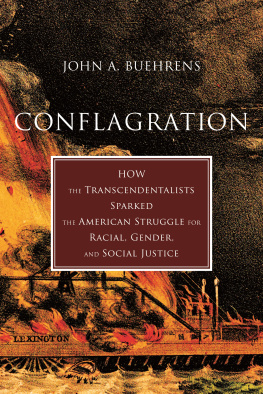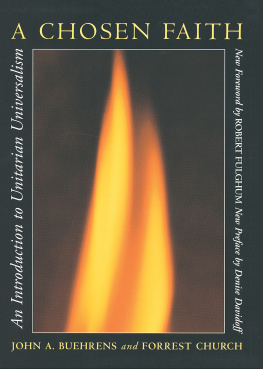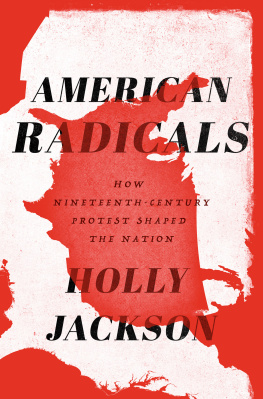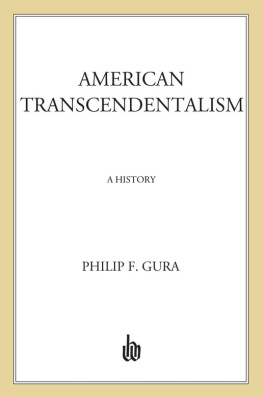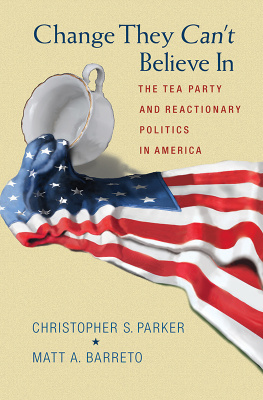Table of Contents
Pagebreaks of the print version
Guide

There is properly no history,
only biography.
RALPH WALDO EMERSON
LEADING DRAMATIS PERSONAE
Charles Follen and Eliza Lee Cabot Follen
William Ellery Channing
Elizabeth Palmer Peabody
Ralph Waldo Emerson
Frederic Henry Hedge
Lydia Maria Francis Child
George and Sophia Dana Ripley
James Freeman Clarke and Anna Huidekoper Clarke
Horace Mann and Mary Peabody Mann
Nathaniel Hawthorne and Sophia Peabody Hawthorne
Sarah Margaret Fuller and Giovanni Ossoli
Theodore Parker and Lydia Cabot Parker
Caroline Wells Healey Dall
Lewis Hayden
Henry David Thoreau
John Albion Andrew
Thomas Wentworth Higginson and Mary Channing Higginson
George Luther Stearns
Franklin B. Sanborn
Samuel Gridley Howe and Julia Ward Howe
Henry Whitney Bellows
Thomas Starr King
William James Potter
Emily Dickinson
Frederick Douglass
John Muir
Grandchildren of the Revolution
MANY OF US FIRST MEET the Transcendentalists in literature classes in high school or college. This gives us the impression that we should think of them primarily as writers. We read some Emerson: a few poems and essays, probably including Self-Reliance. Thoreaus Walden, about going to the woods to live more deliberately, is now the most read American book written before the Civil War. We then come to see Transcendentalists as centered in rural Concord, asserting their individualism against the demands of society. Perhaps it does not help that our meeting with them often comes in our own adolescence, when the drive to self-differentiation, individuation, and idealism is natural.
History provides another perspective, focused less on their writings than on their lives and deeds. Many Transcendentalists and their followers were also fervent activists, sparking the intellectual, spiritual, moral, and political struggle in America for racial, gender, social, and environmental justice that continues to this day. They also were far more religious and urban than most people realize. This is because history also has a tendency to erase many lives and the places associated with them. Here we will lift up less well-known Transcendentalists who were courageous in challenging tradition and injustice. Rather than being pushed around by history, they were great souls who instead tried to shape ittoward a more just, hopeful future.
The Transcendentalists truly did change American history. Many were grandchildren of leaders in the first American Revolution. Emersons grandfather, from the Old Manse in Concord, watched it all begin at the Old North Bridge. Theodore Parkers grandfather, Captain John Parker, led the Minutemen on the town common in Lexington that same morning of April 19, 1775. Both Emerson and Parker were peace-loving ministers. Yet like most Transcendentalists, they gradually came to realize that ending slavery in America was a moral imperative that would require the conflagration, strife, and sacrifice of a second American Revolution. They refused to obey the Fugitive Slave Act. Parker even backed that most radical, violent white abolitionist, John Brown.
Frederick Douglass, by then Americas most articulate and famed fugitive slave, foresaw that Browns plan to start a slave insurrection would fail. Yet he agreed with Parkers call for a second American revolution. In a speech he gave in May 1857, in response to the Dred Scott decision, he quoted verses that he had written earlier that year:
The fire thus kindled, may be revived again;
The flames are extinguished, but the embers remain;
One terrible blast may produce an ignition,
Which shall wrap the whole South in wild conflagration.
Emerson and Thoreau helped to make Brown the Christlike martyr whose death might make even civil war redemptiveif it resulted in ending slavery. When that war came, some Transcendentalists surprised even themselves by organizing the greatest humanitarian relief effort in American history to that date. They sometimes presented themselves as coming to their convictions out of their own immediate inspiration. Yet to understand them properly, we would do well to begin the story of the Transcendentalists with their wisest, most courageous teachers and mentors.
Karl (Charles) Follen and William Ellery Channing were among the most important. The former was a German-born radical and migr turned Unitarian minister and abolitionist. He taught at Harvard from 1825 to 1835, bringing to his teaching of future Unitarian ministers a direct connection to the transcendental ethics and German idealism then stirring among them. When Harvard fired him for being an abolitionist, Channing mentored him into the ministry and made him his personal representative in antislavery circles. When he died in January 1840, in the Conflagration of the Steamer Lexington, on Long Island Sound, that tragedy became in retrospect almost a prophetic sign for the nation as a whole: a ship laden with slave-picked cotton, steaming ahead, no one steering, toward the conflagration of civil war. Follens death profoundly influenced the last years of the one spiritual mentor whom all Transcendentalists gladly acknowledged: Dr. Channing, the spiritual founder of American Unitarianism and of liberal theology. Even Emerson referred to Dr. Channing as our bishop.
To a degree often overlooked, Transcendentalism was a movement almost entirely within the congregational churches of the Boston area that had become Unitarian. It was a spiritual and moral renewal movement among ministers and laypeople in those churches. It is also almost impossible for many readers in our secular culture to realize how influential churches were in mid-nineteenth-century America, especially in Boston, the epicenter of its dominant religious culture, although historian Sidney E. Mead once wisely called us The Nation with the Soul of a Church.
The Transcendentalist movement called forth efforts to make liberal religion more genuinely democratic and more effective in bringing about the many reforms needed to make society more democratic as well. Channing was not only a mentor to Follen, and to almost all the Transcendentalist ministers, but also to lay reformers such as Dorothea Dix, in her crusade for decent care of the mentally ill, and Horace Mann, in his work to promote high-quality, tax-supported public education for all. Perhaps Channings closest spiritual disciple (at least in her own mind) was Elizabeth Palmer Peabody. She considered him the true founder of Transcendentalism in New England (whether he did or not), since it was he who had introduced her to the writings of Samuel Taylor Coleridge, to the word transcendental, and to a distinction between mere empirical understanding and more transcendent, intuitive reason.
Many today regard rural Concord as the geographic center of the Transcendentalist movement. Again, history suggests otherwise. Prosperous Concord has been able to preserve many places associated with Emerson, Thoreau, Alcott, and Hawthorne. Their graves lie along Authors Ridge in Sleepy Hollow Cemetery. The Emerson House, the Old Manse, the Alcotts Orchard House, and Hawthornes last home, The Wayside, all receive visitors. Walden Pond is a popular state park. In Boston, by contrast, many homes, churches, public halls, and places associated with the social activism of the Transcendentalists simply disappeared as the city grew. Only a few sites still remainamong the homes, perhaps only Channings townhouse on Beacon Hill, at 83 Mount Vernon Street, and across the common, at 13 West Street, the shell of what was once the home and bookstore of Elizabeth Peabody.

